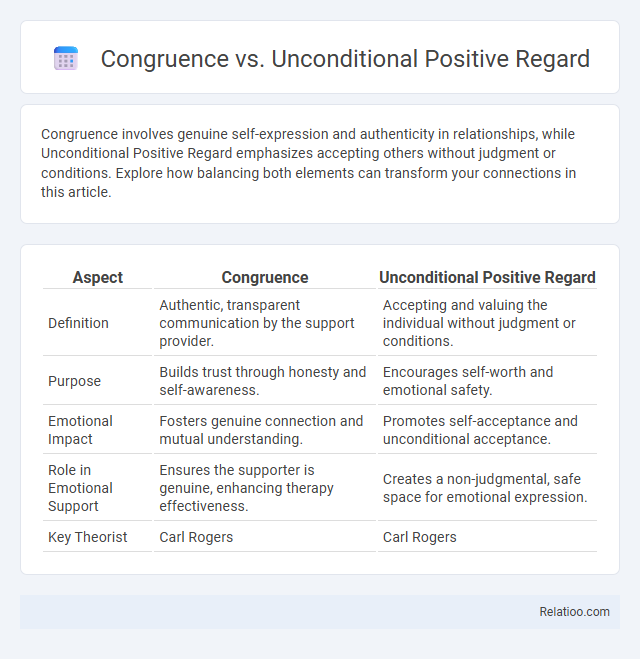Congruence involves genuine self-expression and authenticity in relationships, while Unconditional Positive Regard emphasizes accepting others without judgment or conditions. Explore how balancing both elements can transform your connections in this article.
Table of Comparison
| Aspect | Congruence | Unconditional Positive Regard |
|---|---|---|
| Definition | Authentic, transparent communication by the support provider. | Accepting and valuing the individual without judgment or conditions. |
| Purpose | Builds trust through honesty and self-awareness. | Encourages self-worth and emotional safety. |
| Emotional Impact | Fosters genuine connection and mutual understanding. | Promotes self-acceptance and unconditional acceptance. |
| Role in Emotional Support | Ensures the supporter is genuine, enhancing therapy effectiveness. | Creates a non-judgmental, safe space for emotional expression. |
| Key Theorist | Carl Rogers | Carl Rogers |
Understanding Congruence in Psychology
Congruence in psychology refers to the alignment between a person's self-perceptions and their actual experiences, fostering authenticity and psychological well-being. Unconditional Positive Regard, a concept introduced by Carl Rogers, involves accepting and valuing a person without conditions, which supports the development of congruence by reducing internal conflict and promoting self-acceptance. Understanding congruence helps you recognize the importance of genuine self-expression and harmonious self-awareness in personal growth and effective therapeutic relationships.
Defining Unconditional Positive Regard
Unconditional Positive Regard refers to accepting and valuing a person without judgment, regardless of their behavior or feelings. This concept, rooted in Carl Rogers' humanistic psychology, emphasizes offering genuine care and support to foster an individual's growth and self-awareness. Your emotional development benefits from this acceptance, as it promotes openness and authenticity without conditions or expectations.
Origins: Carl Rogers and Humanistic Theory
Carl Rogers, a pioneering figure in humanistic psychology, introduced the concept of congruence as the alignment between an individual's self-perception and experience, which fosters psychological well-being. Unconditional Positive Regard, also developed by Rogers, emphasizes accepting and valuing a person without conditions, creating a supportive environment crucial for personal growth. Your understanding of these foundational concepts highlights their roots in Rogers' humanistic theory, which prioritizes authentic self-expression and empathy in therapeutic settings.
Key Differences Between Congruence and Unconditional Positive Regard
Congruence refers to the therapist's genuineness and authenticity, ensuring alignment between their inner feelings and outward expressions, while Unconditional Positive Regard involves accepting and valuing clients without judgment, regardless of their behaviors or feelings. The key difference lies in congruence being self-focused on the therapist's transparency, whereas unconditional positive regard is client-focused, emphasizing nonjudgmental acceptance. Together, these concepts foster a therapeutic environment that promotes trust, openness, and personal growth.
The Role of Authenticity in Congruence
Authenticity plays a critical role in congruence by ensuring that an individual's external expressions genuinely reflect their internal experiences, fostering self-awareness and emotional honesty. Unconditional positive regard, while essential for creating a supportive environment, emphasizes acceptance without judgment and does not guarantee authenticity unless paired with congruence. The synergy between congruence and unconditional positive regard enables true self-expression and psychological growth, as authenticity underpins the alignment of feelings and behaviors.
The Impact of Judgment-Free Acceptance
Judgment-free acceptance, central to Unconditional Positive Regard, creates a safe psychological space where Your authentic self can emerge without fear of criticism or rejection. Congruence, or genuine transparency from the therapist, enhances this environment by modeling honesty and fostering trust essential for emotional growth. Together, these concepts promote profound healing by aligning internal experiences with external expressions, enabling deeper self-awareness and self-acceptance.
Practical Applications in Therapy
Congruence in therapy involves the therapist's genuine authenticity, fostering trust and openness, while Unconditional Positive Regard ensures nonjudgmental acceptance, promoting client self-exploration and growth. You benefit most when these components are integrated, as congruence allows your therapist to be transparent and relatable, and unconditional positive regard creates a safe space for emotional expression. Practical application in therapy uses congruence to model honesty, unconditional positive regard to build acceptance, and together they facilitate deeper client insight and healing.
How Congruence Influences the Therapeutic Relationship
Congruence, characterized by a therapist's genuine authenticity and transparency, significantly enhances the therapeutic relationship by fostering trust and openness between client and therapist. This authenticity contrasts but complements Unconditional Positive Regard, which involves nonjudgmental acceptance, and Empathy, which entails deep understanding; together, these core conditions create a safe environment conducive to client growth. Research shows that high levels of congruence correlate with improved therapeutic outcomes, as clients feel more understood and are encouraged to explore their true selves without fear of rejection.
Unconditional Positive Regard and Client Self-Esteem
Unconditional Positive Regard (UPR) involves accepting and valuing a client without judgment, fostering an environment where Your self-esteem can flourish through genuine acceptance. Congruence, or therapist authenticity, complements UPR by modeling openness and honesty, reinforcing trust in the therapeutic relationship. Emphasizing UPR promotes the client's self-worth and encourages personal growth by affirming intrinsic value regardless of actions or feelings.
Integrating Congruence and Unconditional Positive Regard for Effective Counseling
Integrating congruence and unconditional positive regard enhances counseling effectiveness by fostering an authentic therapist-client relationship where clients feel accepted and understood. Congruence, or therapist genuineness, combined with unconditional positive regard, which entails nonjudgmental acceptance, creates a safe space for clients to explore emotions and promote self-awareness. This integration supports client growth, reduces defensiveness, and facilitates deeper therapeutic change.

Infographic: Congruence vs Unconditional Positive Regard
 relatioo.com
relatioo.com